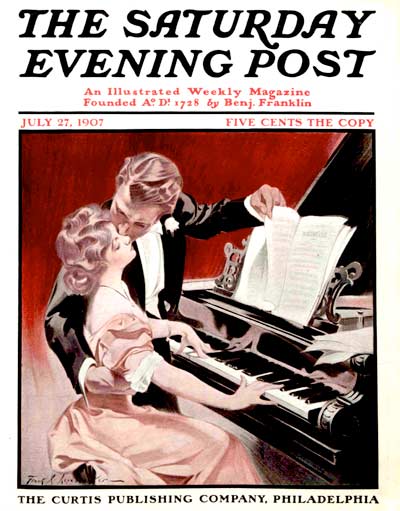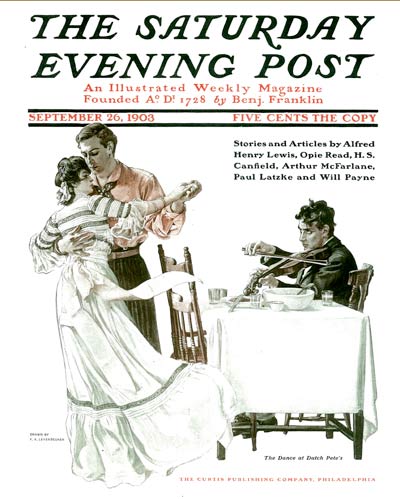
from July 27, 1907
It must have been like having a movie star for a sibling, being the “oh, yeah, you’re the brother” guy.
Frank Xavier Leyendecker was born in Germany in 1879 (or ’76 or ’77, depending upon the source) and from boyhood, he seemed to be something of an afterthought.
After enjoying early success, Frank’s demons of inferiority complex and substance abuse ruled.
This cover is from 1907.
Although the family immigrated to America in 1882, primogeniture still held some sway to the Leyendecker parents, who were determined that older brother Joe (J.C.) receive the training required for future success.
They were somewhat less concerned with their younger son’s prospects, but J.C. conscientiously worked to bring young Frank and his talent along with him, including to Paris in 1886 to study at the Acadèmie Julian.

from September 26, 1903
This 1903 cover, Dancing at Dutch Pete’s, appears to have retained a bit of the Parisian influence the brothers enjoyed.
Paris was the heart of the international art world, and Laurence S. Cutler and Judy Goffman Cutler, authors of a book on J.C., write: “At 22 years of age, J.C. was already considered to be an upcoming art figure alongside such luminaries as … Alphonse Maria Mucha and Henri de Toulouse-Lautrec.”
J.C. was considered the biggest talent to attend the academy in many years, which could be one reason that, while there, “J.C. studied diligently while F.X. tended to focus more on drinking, drugs and carousing with the other art students,” according to art blogger Donald Pittenger.
Like his more successful brother, Frank did commercial work, though he had a bit of an attitude about doing advertisements, feeling he was destined for fine arts. Michael Schau, author of another tome on J.C. Leyendecker, writes, “Whether or not he (Frank) lacked the vision or self-confidence to attempt such work is hard to tell.”

Frank’s earliest success was with Collier’s magazine around the turn of the century. He also did work for Life magazine and, as we see in this stunning 1914 cover, Vanity Fair.
The richness of color is a reminder that Frank was also a stained glass artist and designer. It is also a reminder that, like his brother J.C., Frank’s diversity of style was amazing.
The fragment of his work shown here illustrates passionate, cute, romantic and elegant scenes. We’ll add one more style: the realistic and poignant (see below).
In this 1918 cover, “Soldier Writes Mother a Letter,” a soldier writes by candlelight and in the background we see the sweet white-haired recipient of his letter.
It is Frank’s only cover for Country Gentleman magazine, a sister publication to The Saturday Evening Post, for whom he did 17 covers.

February 23, 1918.
As we have indicated, the Post was by no means their only client, but it is illustrative of the hard-working nature of J.C. that he had done well over 130 covers for them by this time (he was to become the magazine’s most prolific artist, with 322 covers).
Although the creative genius was there, Frank became more depressed and less productive as J.C.’s star continued to rise. After a dispute with J.C.’s partner, Charles Beach, J.C., who had always stayed with his brother, moved out.
The Cutler book on J.C. Leyendecker states: “With nothing else left, no place in the fraternal relationship, a broken spirit, and overshadowed by J.C.’s successes, Frank lapsed further into his sad indulgences.” Depression, heavy drinking, smoking, and drug use culminated in his death at age 45 in April of 1924.
Become a Saturday Evening Post member and enjoy unlimited access. Subscribe now




Comments
Diana, Recently a FXL has gone to auction and declared a fake. Would you please comment on this item of the girl at piano. Would this be a color study using different colors as FXL developed the final painting?
Thank you for this article; I knew nothing about Frank Leyendecker. His work is certainly impressive and it’s sad, I think, how their parents seemed to put JC above Frank and the reverberations it had on Frank. How sad his life ended so young. Also, thanks for referring honestly to Charles Beach as JC Leyendecker’s partner. It seems one reads that all too infrequently.
Thanks Diana, for this wonderful feature on Frank Leyendecker. Normally I’d make specific comments on the individual covers (and ad), but mostly I feel great sadness in knowing how this brilliantly gifted man suffered from so many problems that he shouldn’t have had to.
Since we weren’t there, we can only guess what role family dynamics, jealousy, public/professional and family comments made to him that that he “wasn’t as good as J.C.” and/or “he’ll never measure up” etc. It’s cruelty and devastation of the highest order especially when they result in breaking someone’s spirit. Of course he would have had Depression and would have used drugs and drinking as coping mechanisms.
I think his work is FANTASTIC!! Everything here. I’ve never seen an image in illustration like the Country Gentleman cover depicting the woman in his mind like this. It’s really like something I’ve only seen on film using special effects. Life was very unfair to this man; he was a true genius.